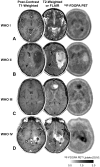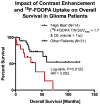18F-FDOPA PET and MRI characteristics correlate with degree of malignancy and predict survival in treatment-naïve gliomas: a cross-sectional study
- PMID: 29679199
- PMCID: PMC6092195
- DOI: 10.1007/s11060-018-2877-6
18F-FDOPA PET and MRI characteristics correlate with degree of malignancy and predict survival in treatment-naïve gliomas: a cross-sectional study
Abstract
Introduction: To report the potential value of pre-operative 18F-FDOPA PET and anatomic MRI in diagnosis and prognosis of glioma patients.
Methods: Forty-five patients with a pathological diagnosis of glioma with pre-operative 18F-FDOPA PET and anatomic MRI were retrospectively examined. The volume of contrast enhancement and T2 hyperintensity on MRI images along with the ratio of maximum 18F-FDOPA SUV in tumor to normal tissue (T/N SUVmax) were measured and used to predict tumor grade, molecular status, and overall survival (OS).
Results: A significant correlation was observed between WHO grade and: the volume of contrast enhancement (r = 0.67), volume of T2 hyperintensity (r = 0.42), and 18F-FDOPA uptake (r = 0.60) (P < 0.01 for each correlation). The volume of contrast enhancement and 18F-FDOPA T/N SUVmax were significantly higher in glioblastoma (WHO IV) compared with lower grade gliomas (WHO I-III), as well as for high-grade gliomas (WHO III-IV) compared with low-grade gliomas (WHO I-II). Receiver-operator characteristic (ROC) analyses confirmed the volume of contrast enhancement and 18F-FDOPA T/N SUVmax could each differentiate patient groups. No significant differences in 18F-FDOPA uptake were observed by IDH or MGMT status. Multivariable Cox regression suggested age (HR 1.16, P = 0.0001) and continuous measures of 18F-FDOPA PET T/N SUVmax (HR 4.43, P = 0.016) were significant prognostic factors for OS in WHO I-IV gliomas.
Conclusions: Current findings suggest a potential role for the use of pre-operative 18F-FDOPA PET in suspected glioma. Increased 18F-FDOPA uptake may not only predict higher glioma grade, but also worse OS.
Keywords: 18F-FDOPA PET; Biomarker; Glioma; MRI.
Figures




Similar articles
-
Rate of change in maximum 18F-FDOPA PET uptake and non-enhancing tumor volume predict malignant transformation and overall survival in low-grade gliomas.J Neurooncol. 2020 Mar;147(1):135-145. doi: 10.1007/s11060-020-03407-w. Epub 2020 Jan 24. J Neurooncol. 2020. PMID: 31981013 Free PMC article.
-
Maximum Uptake and Hypermetabolic Volume of 18F-FDOPA PET Estimate Molecular Status and Overall Survival in Low-Grade Gliomas: A PET and MRI Study.Clin Nucl Med. 2020 Dec;45(12):e505-e511. doi: 10.1097/RLU.0000000000003318. Clin Nucl Med. 2020. PMID: 33031233 Free PMC article.
-
A high 18F-FDOPA uptake is associated with a slow growth rate in diffuse Grade II-III gliomas.Br J Radiol. 2018 Apr;91(1084):20170803. doi: 10.1259/bjr.20170803. Epub 2018 Jan 12. Br J Radiol. 2018. PMID: 29271237 Free PMC article.
-
Diagnostic and grading accuracy of 18F-FDOPA PET and PET/CT in patients with gliomas: a systematic review and meta-analysis.BMC Cancer. 2019 Aug 5;19(1):767. doi: 10.1186/s12885-019-5938-0. BMC Cancer. 2019. PMID: 31382920 Free PMC article.
-
Increasing feasibility and utility of (18)F-FDOPA PET for the management of glioma.Nucl Med Biol. 2015 Oct;42(10):788-95. doi: 10.1016/j.nucmedbio.2015.06.001. Epub 2015 Jun 9. Nucl Med Biol. 2015. PMID: 26162582 Review.
Cited by
-
Usefulness of 18F-FDOPA PET for the management of primary brain tumors: a systematic review of the literature.Cancer Imaging. 2020 Oct 6;20(1):70. doi: 10.1186/s40644-020-00348-5. Cancer Imaging. 2020. PMID: 33023662 Free PMC article.
-
Approaches to PET Imaging of Glioblastoma.Molecules. 2020 Jan 28;25(3):568. doi: 10.3390/molecules25030568. Molecules. 2020. PMID: 32012954 Free PMC article. Review.
-
Rate of change in maximum 18F-FDOPA PET uptake and non-enhancing tumor volume predict malignant transformation and overall survival in low-grade gliomas.J Neurooncol. 2020 Mar;147(1):135-145. doi: 10.1007/s11060-020-03407-w. Epub 2020 Jan 24. J Neurooncol. 2020. PMID: 31981013 Free PMC article.
-
Multiparametric MR-PET measurements in hypermetabolic regions reflect differences in molecular status and tumor grade in treatment-naïve diffuse gliomas.J Neurooncol. 2020 Sep;149(2):337-346. doi: 10.1007/s11060-020-03613-6. Epub 2020 Sep 14. J Neurooncol. 2020. PMID: 32929644 Free PMC article.
-
Integration of dynamic parameters in the analysis of 18F-FDopa PET imaging improves the prediction of molecular features of gliomas.Eur J Nucl Med Mol Imaging. 2020 Jun;47(6):1381-1390. doi: 10.1007/s00259-019-04509-y. Epub 2019 Sep 16. Eur J Nucl Med Mol Imaging. 2020. PMID: 31529264
References
-
- Stupp R, Taillibert S, Kanner AA, Kesari S, Steinberg DM, Toms SA, Taylor LP, Lieberman F, Silvani A, Fink KL, Barnett GH, Zhu JJ, Henson JW, Engelhard HH, Chen TC, Tran DD, Sroubek J, Tran ND, Hottinger AF, Landolfi J, Desai R, Caroli M, Kew Y, Honnorat J, Idbaih A, Kirson ED, Weinberg U, Palti Y, Hegi ME, Ram Z. Maintenance Therapy With Tumor-Treating Fields Plus Temozolomide vs Temozolomide Alone for Glioblastoma: A Randomized Clinical Trial. JAMA. 2015;314:2535–2543. - PubMed
-
- Stupp R, Taillibert S, Kanner A, Read W, Steinberg DM, Lhermitte B, Toms S, Idbaih A, Ahluwalia MS, Fink K, Di Meco F, Lieberman F, Zhu JJ, Stragliotto G, Tran DD, Brem S, Hottinger AF, Kirson ED, Lavy-Shahaf G, Weinberg U, Kim CY, Paek SH, Nicholas G, Burna J, Hirte H, Weller M, Palti Y, Hegi ME, Ram Z. Effect of Tumor-Treating Fields Plus Maintenance Temozolomide vs Maintenance Temozolomide Alone on Survival in Patients With Glioblastoma: A Randomized Clinical Trial. JAMA. 2017;318:2306–2316. - PMC - PubMed
MeSH terms
Substances
Grants and funding
LinkOut - more resources
Full Text Sources
Other Literature Sources
Medical
Research Materials

